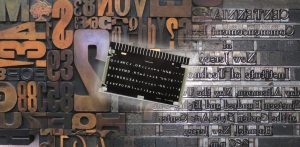By Bob Wislocky

Typography has always been one of my greatest passions. The use and display of countless type styles and their impact on every creative undertaking is fascinating. With that in mind, I would like to share the journey of how it all began and how it has led us to where we are today.
Typography is the art of creatively assembling type to make it aesthetically pleasing, proofreading to attain zero errors, critiquing and refining the type layout to ensure the reader will be pleased with the visual presentation and readability.
Around 1450, Johanne Guttenberg of Mainz, Germany invented the first printing press to use metal movable type (commonly known as hand type). Movable type predated Guttenberg but he developed his type fonts from an alloy of lead, tin and antimony which was less costly and more durable than earlier wood or porcelain type. His invention of metal movable type started the printing revolution with a plethora of new font designs. Guttenberg was a typographer. He was a master of creating pages that were so aesthetically pleasing that those pages could be considered art.
Guttenberg set the standard for font designers and typographers to build upon. Many fonts used for body copy (6 to 14 point) were designed to be “legibility fonts” where words could be easily recognized and read without effort. Display type (18 to 72 point & up) was designed to evoke a mood and get attention.
Typographers understood the importance of type readability and aesthetics to improve comprehension and attention. The details of such craftsmanship were demonstrated by the selection of the correct point size and leading; using minimal hyphenation; avoiding widows and orphans; and kerning necessary letter combinations. Understanding the use and importance of white space improved readability. These are just a sampling of the styling attributes typographers adhered to. Most importantly, typographers understood the need for extensive quality control. Utilizing highly skilled proofreaders to identify errors and critique the type composition provided a final product the typographer and client could be proud of.
There was a huge demand for the printed word during the industrial revolution of the late 1800’s. The Linotype and Intertype hot metal linecasters, the Monotype that cast individual letters of metal movable type into lines and Ludlow display type linecaster were invented to speed up the process of setting text and display matter. Typographers and book publishers stayed true to their craft by seeking quality typography but other segments of the printing industry, including newspapers and magazines, gave less attention to high quality to meet stringent deadlines.
When the early first generation phototypesetting machines were introduced from the late 1940’s through the early 1960’s, type resolution was much higher and sharper but productivity suffered. It was still much easier to edit and correct metal type than strip film during the revision process. Hence phototypesetting was used for high-end advertising typography but jobs that contained a lot of body copy remained in hot metal.
It was not until the late 1960’s, when second generation phototypesetting machines were introduced, that typographers gained the ability to edit files and gain better control of typographic aesthetics such as automatic kerning. Typographic quality and productivity increased to the extent that it had finally brought about the demise of hot metal typography which lasted over 500 years. Guttenberg would have been amazed to watch typographers compose high quality phototypography and pleased to know they didn’t abandon the high bar he established for future generations.
In the weeks ahead, I will share my perspective of how typography was enhanced and affected during the eras of 3rd generation phototypesetting and 4th generation imagesetting, as well as the changing marketplace.